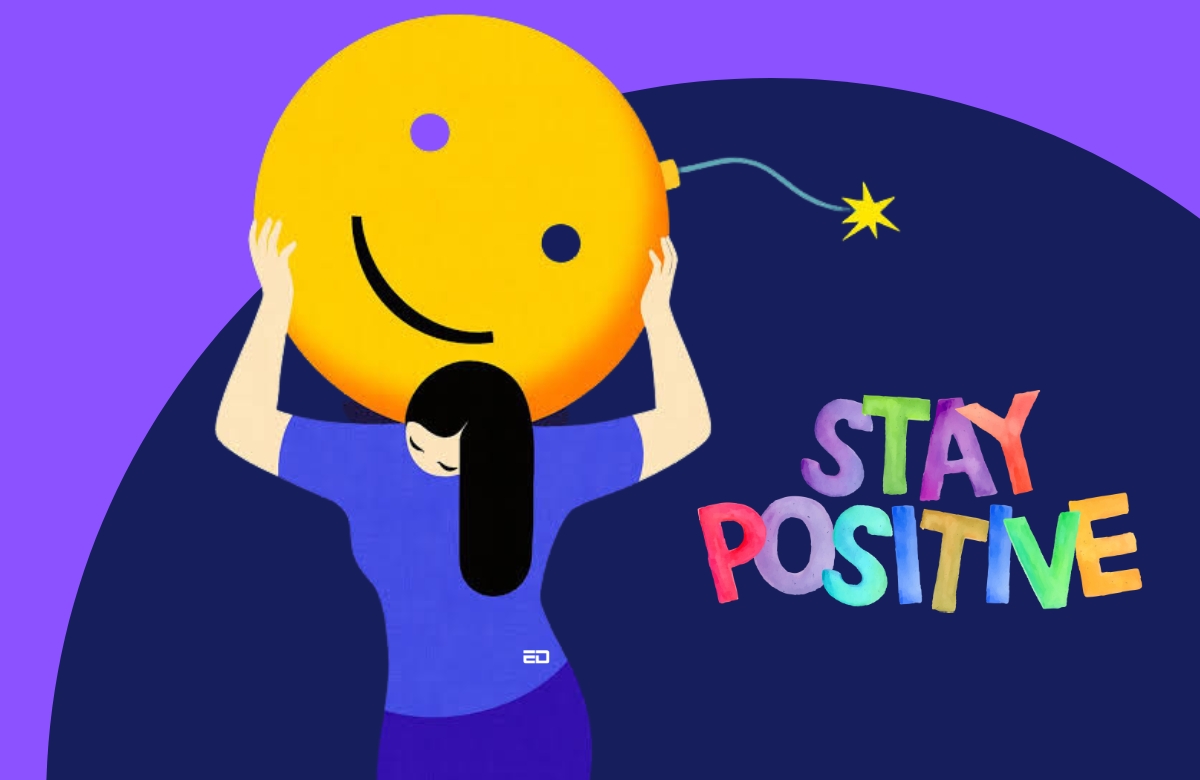Toxic positivity is a positive approach towards every situation, no matter how dire or difficult. It is an emotional facade where one fools themselves and others that everything is alright, even when things are not. It is a form of gaslighting.
While having a positive outlook towards life is necessary, it is also important to distinguish between toxic positivity and optimism. It is crucial to feel all emotions and– good and bad– and understand personal feelings before forging ahead on the journey of self-healing and self-growth.
There is a fine line between optimism and toxic positivity.
Toxic Positivity VS Optimism
Dr. Martin Seligman describes optimism as a reaction to problems that is encouraged by a sense of confidence and high personal ability. This approach negates the value of a negative experience, limits its scope and also makes the impact of this temporary experience less daunting.
It is a way in which a person identifies their mistakes, acknowledges the pain and humiliation associated with them, and moves on by learning and aiming to not repeat the follies which caused the said negative experience.
It can be argued that an optimistic person is more likely to learn and adapt because of a negative experience in a healthier manner.

Toxic positivity, on the other hand, is an approach where a person downplays and shames any associated emotion connected to a negative experience. The method to cope in this situation is to ignore the pain and humiliation, to move forward by toughening up and determinedly looking at the bright side of things.
Indeed, looking at the bright side of things is arguably a good way to console oneself but it is not wise to not learn from any given experience.
Hence, it can also be argued that toxic positivity hinders personal growth as it stops people from processing their pain and understanding where they went wrong.
There is a vehement urge to put the episode behind them and move forward without taking a moment to reflect on how to be better in the future. Toxic positivity may lead to repeated mistakes and turn into a vicious circle.
Read More: Toxic Positivity Vs Genuine Optimism: How They Influence You?
Example of Toxic Positivity
We often do not realise whether we are being optimistic or leaning towards toxic positivity.
Scene: Your friend loses his job. You want to be there for him and you tell him that whatever happened was for the best and that his boss was a jackass anyway. You are able to make him laugh and bring a smile to his face. You feel good that you made him feel better and you go home thinking that your job is done.
What really happened: You did not acknowledge your friend’s fear and apprehension for the future. The smile on his face is temporary. He still has to go through self-doubt and a lack of self-confidence but now he is misdirected.
What you could have done: You could have asked him about how this situation came to be and helped him recognise and accept his flaws. You could have reassured him that things will be fine if he put in the work and did not repeat his mistakes. You could have helped him build his resume and look for other jobs.
Signs That You Are Not Optimistic But Adopt Toxic Positivity
- You don’t face problems but brush them off. Your problems will not magically disappear if you sweep them off under the rug. Problems require work and effort. The longer you wait, the more daunting it will become.
- You hide your feelings. You do not want to be seen as hurt and humiliated and hence you put on a forced smile and convince everyone, including yourself, that everything is fine when it’s clearly not.
- You negate other people’s feelings when you feel uncomfortable. The fact that you have made yourself stoic does not change other people’s approach toward difficulties. Yet you forget to understand that and consider them to be weak to be giving in to their emotions.
- You feel guilty of having emotions. You are confused about having them as you have already convinced yourself that things are fine.
How To Cope With Toxic Positivity
- Let yourself feel whatever you are feeling. Remember that you do not curb your happiness. Your sadness deserves the same respect.
- You can manage your negative emotions without denying them. The point is to acknowledge your pain but eventually move on from it by keeping the lessons in mind.
- Treat others the way you would want to be treated. Do not negate other people’s feelings by shutting them down by toxic positivity. Make them feel heard and supported.
How To Avoid Toxic Positivity
It is always wise to be mindful of what you are doing or feeling. It is understandable that that is difficult in an age where everything seems to demand your attention. We are a generation of overstimulated people and it is quite easy to redirect our emotions by distracting ourselves.
You may think that not crying over an event or a person makes you powerful but that is not the case. Bottling up of emotions is a dangerous coping mechanism as it can lead to more problems and stressed relationships.
Thus, it is wise to be careful with yourself and take care of your mental health. Being mindful of every step you take is a difficult but worthwhile step in your journey of a healthier life.
Have you ever experienced toxic positivity? How did it affect you? Let us know in the comment section.
Image Credits: Google Images
Feature Image designed by Saudamini Seth
Sources: Very Well Mind, Right As Rain, LinkedIn
Find the blogger: Pragya Damani
This post is tagged under: Toxic Positivity, Genuine Optimism, Mental Health, Process, Emotions, Feelings, Mental Health Organization, Invalidating Opinions, Mental State, Feel Your Emotions
Disclaimer: We do not hold any right, copyright over any of the images used, these have been taken from Google. In case of credits or removal, the owner may kindly mail us.


































